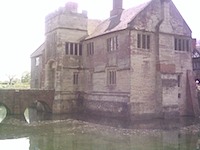Ghostly Bloodstains & Priest Holes, in beautiful Warwickshire countryside.
At first glance you might think Baddesley Clinton was simply a perfect example of a medieval moated manor house, leading a quiet existence in the depths of the Warwickshire countryside. But don't let that fool you. Baddesley Clinton may look like a chocolate box image, but inside, it's born witness to murder and religious strife.
There has been a house on the site since the 1290's, when the Clinton family became owners of the manor. In 1438, the manor was bought by John Brome, Henry VI's Under Treasurer. It was a turbulent time in English history and John was killed during a dispute in 1468. His son, Nicholas, avenged his father in 1471, killing his murderer. Later, when Nicholas had become the owner of Baddesley, he caught the local priest 'chockinge his wife under ye chinne' and promplty killed him.
An indelible bloodstain remains is the Solar - now the Library - is it a ghostly manifestation of the poor priest's blood? Who knows, but the children love to see it! For many years, occupiers of the house believed the room to be haunted, hearing various noises there, until a doughty Victorian mother forbad talk of such things.
Nicholas Brome had the nearby church of St. Michael built as part of his penance for the murder. It's worth the short stroll along the path from the house to see the church too.
The house has another secret too. After the Reformation, the Ferrers remained devout Catholics, something that caused great difficulty in Elizabethan and Jacobean England. Henry Ferrers had three Priest or Hiding Holes built at the house, to hide Jesuit priests who continued to visit the area, administering Mass to the faithful. It was dangerous, because priests and anyone giving them shelter was liable to be hanged.
You can still see where the holes are, including the one that is hidden in a privy (toilet). It's fun for us today, but imagine the fear they felt when a search took place. Fortunately for them, no one was discovered at Baddesley Clinton.
In the 1590s, the house was let to two Vaux sisters. They lived there during the time of the Gunpowder Plot and were connected to the conspiracy. If you're interested, the best book I know for giving you a fantastic feel for the time, is Antonia Fraser's 'The Gunpowder Plot, Terror & Faith in 1605'.
Inside, the house has a very strong feel of the Elizabethan and Jacobean. Wooden paneling and mullion windows, four-poster beds, painted walls, stained glass, it's the real thing. It's one of those houses where you fell that you'd almost be able to move in tomorrow and feel at home.
For a house with such a colourful history, it manages to present a tranquil, calm atmosphere. It even smells lovely.
The moat which surrounds the house is beautiful. It leads out to stew ponds, where in days gone by fish were kept to feed them, especially on the many days when it was not permitted to eat meat.
Now the gardens are there simply to enjoy. It's possible to walk around a route that tales you from the house, around the lakes and back. If the weather is good, it's a lovely way to end the visit.

